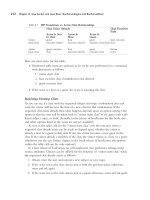Xiaomi’s journey in India: a roller coaster ride
Bạn đang xem bản rút gọn của tài liệu. Xem và tải ngay bản đầy đủ của tài liệu tại đây (373.86 KB, 8 trang )
International Journal of Management (IJM)
Volume 11, Issue 3, March 2020, pp. 55–62, Article ID: IJM_11_03_007
Available online at />Journal Impact Factor (2020): 10.1471 (Calculated by GISI) www.jifactor.com
ISSN Print: 0976-6502 and ISSN Online: 0976-6510
© IAEME Publication
Scopus Indexed
XIAOMI’S JOURNEY IN INDIA: A ROLLER
COASTER RIDE
Anuj Kumar*
Assistant Professor, Bharati Vidyapeeth Institute of Management and Research,
New Delhi, India
Dr. Nishu Ayedee
Assistant Professor, Bharati Vidyapeeth Institute of Management and Research,
New Delhi, India
Dr. Nimit Gupta
Associate Professor, Fortune Institute of International Business,
New Delhi, India
*Corresponding Author E mail:
ABSTRACT
Xiaomi entered in Indian market in 2014. After China, India was most important
market for Xiaomi. With the help of this case, the authors will discuss about market
entry and initial success of Xiaomi in India. Culture plays an important role for any
foreign market player. In this case, there will a discussion on cultural similarity
between India and China too. Slowly and gradually Xiaomi become the most dominant
player in the smartphone segment in India. With the help of this case the authors will
explain market entry strategies and unique business model of the company that helped
it to gain maximum market share. This case can be useful for management students as
well as professionals to learn about business success of Xiaomi and the complexities
of Indian market. Culture and its implications are crucial for Xiaomi to move to next
level after the initial success with penetration of new technology and shut down of
Indian based handset manufacturer’s brand, it is not easy for any foreign brand to
penetrate and move beyond.
Keywords: Xiaomi, India, Smartphone, Culture, Internationalization, Marketing.
Cite this Article: Anuj Kumar, Dr. Nishu Ayedee, Dr. Nimit Gupta, Xiaomi’s
Journey in India: A Roller Coaster Ride, International Journal of Management (IJM),
11 (3), 2020, pp. 55–62.
/>
/>
55
Xiaomi’s Journey in India: A Roller Coaster Ride
1. INTRODUCTION
Xiaomi Inc. is a Chinese electronics company entered Indian market on July 15, 2014 with an
exclusive sales tie-up with Flipkart for smartphones Mi3. Xiaomi is a privately owned
manufacturer of China headquartered at Beijing. Manu Kumar Jain is the managing director
of Xiaomi, India. Xiaomi joined the race in smartphones segment with competitors like
Samsung, Apple and Lenovo. Indian market can be seen as a combination of second highest
number of people spending time on smart phone, high combination of sales volume and an
attractive market for foreign vendors. There has been a tough competition between local
manufacturers and Chinese vendors in Indian smart phone market. Cultural impact is very
much visible in Indian smart phone industry. Indian consumers are emotionally and culturally
attached in buying their products especially handsets. Xiaomi is no exception in India.
Understand the marketing strategy of foreign brand and its success factors
Analyse the competitive framework of Indian smartphone market
Develop their understanding about culture, pricing and other key factors play major
role in Indian smartphone segment is case drafted keeping in mind about following
objectives:
2. ABOUT XIAOMI
Xiaomi was founded in 2010 and in 2017 it is world’s 5th largest smartphone maker. Xiaomi
is manufacturing variety of products which include smartphones, mobile apps, laptops, and
related consumer electronics. Lei Jun is the founder and CEO of Xiaomi and Lin Bin is the
president of the company. A team of experts from top multinational companies are working
behind the success of Xiaomi; there has been top nine- leadership positions in company are
occupied by ex-Googlers. Xiaomi has been called the Apple of China because the USP of the
company is to provide the features similar to Apple at cheap price. The smartphone users are
finding features of Xiaomi smartphone similar to Apple smartphones. The management and
technical team of Xiaomi is providing an excellent experience to the customers at cheap price.
The pricing of Xiaomi is very low in comparison to Apple phone. The youngsters between
the age group of 18-34 years are preferring Xiaomi in comparison to Apple because the
company is providing excellent features at affordable price. The number of employees are
currently 15000 and the revenue of the company is US $ 15 billion. Since the inception of
company, it expanded itself to India, Malaysia, Singapore and other countries.
3. INDIAN SMARTPHONE MARKET
The smart phone market is growing at rapid pace in India. India is counted as most popular
destination for smart phone companies. Those companies see enormous growth options in
culturally scattered Indian market. It has been estimated that till 2022 the number of smart
phone users in India will increase to about 442.5 million. India is the world’s second largest
smart phone market after China. As per the reports from IDC, the smart phone market in India
grew 14.5 % in 2018 with a shipment of 142.3 million units. In comparison to 2018, previous
year shipment was 124.3 million units. The biggest highlight of smart phone market in 2018
is the online focused brands that drove the share of online channel to an all-time high of 38.4
% in 2018. Some of the important pointers for this market includes.
/>
56
Anuj Kumar, Dr. Nishu Ayedee, Dr. Nimit Gupta
Higher growth rate and Wide scope for smart phone companies
Smart phone penetration is high because millions of people are still without smart
phone
Consumers want budgeted smart phone
Xiaomi, Samsung, One Plus and Apple are increasing their market share
Collectivistic culture and most number of buyers in the age group of 18-24 years
Chinese vendors are strengthening their position in Indian smart phone market. The
collective share of China- based reached 53 % in 2017 in comparison to 34% in 2016. The Q4
highlights of Indian smart phone market suggested that India’s overall mobile phone market
grew by 11% and smart phone shipments have been increased by 10%. The overall revenue of
the smart phone companies has been increasing. In terms of market share, Xiaomi is the
market leader. Xiaomi has been followed by Samsung, Vivo, Oppo, Micromax and others.
Xiaomi led the smart phone market in India in 2018 with a 28% market share followed by
Samsung 24%, Vivo 10%, Oppo 8% and Micromax 5%. India is just surpassed 430 million
smart phone users. One plus is the premium brand in smart phone market with 58% growth on
year-on-year basis.
We are in 2019, still India has tremendous untapped potential when it comes smart phone
market segment. India has a vast majority of 1.3 billion who are either without smart phone of
prefer budget smart phone. Hofstede talked about six cultural dimensions- power distance,
individualism versus collectivism, masculinity versus femininity, long term orientation versus
short term orientation, uncertainty avoidance and indulgence. In my opinion three cultural
dimensions have affected the smart phone sales in Indian smart phone industry. India has high
score for collectivism so people often buy after getting positive feedbacks or
recommendations from family, friends and relatives. The buyers also suggest the same brand
to their closed ones. If a company is providing budgeted smart phone with all essential
features than it will go viral in the market. Indian people have high score for long term
orientation. They take time in trusting a brand or product but their orientation is not as long as
the Chinese citizen has. Once the brand is doing well in India market, it will continue doing
well because people have developed enough faith in that brand. India has high score for
masculinity. It means Indian culture is driven by success and power. People often purchase
mobile phone as status symbol and they connect it with their success. As per demographic
data, the highest percentage of attraction for smart phone is in the age group of 18-24 years.
Mostly students and entry-level professionals fall in the age group of 18-24 years. They want
a budgeted smart phone which fulfil their expectations of all the essential features as well.
Indian market is providing excellent growth options for smart phone companies because out
of 900 million Indians having a subscription over mobile phones, only 110-120 million are
using smart phones. Smart phone penetration rate is high in India.
4. JOURNEY OF XIAOMI IN INDIA
As per International Data Corporation report, Xiaomi is jointly number one along with
Samsung in terms of market share in Smartphone industry. China and India are fighting for
toughest Smartphone wars in developing market region. The population in both the countries
is at maximum level and the numbers of Smartphone users are also increasing. Chinese
market has one drawback in comparison to India that the population of China is growing old.
The primary buyers of Xiaomi Smartphone are youngsters. The percentage population of
youngsters in India is higher in comparison to China. In Indian market, there are more people
in the age group of 22-34 years so this market can generate excellent revenue for the
company. Keeping an eye over increased demand of smartphones, Xiaomi entered in India in
/>
57
Xiaomi’s Journey in India: A Roller Coaster Ride
July 2014 when it launched its first Smartphone, Mi3. Xiaomi didn’t enter India in huge
manner like other multinationals. Xiaomi entered in Indian market through online distribution
channel. The “Flash Sale” model was adopted by Xiaomi in Indian market. A flash sale is a
discount or promotion offered by an ecommerce store for a short period of time. In this type
of sale, the quantity is often limited and the discounts are more significant. The company
preferred online retailing through Flipkart to cut out margin and to pass the benefits to the
customers. Xiaomi also put more focus on its own Mi online stores to sell its wares. The
online selling is not a frequent medium to conquer Indian market as Indian customers prefer
to buy things offline. Both Motorola and Xiaomi are trying to sell their phones through online
channels. The numbers of online retail outlets are not big in number as one Smartphone brand
needs 20-25K outlets but the number of retail outlets in the country is only 400K.
Initially Xiaomi only made available a limited stock of devices in the Indian market. Mi3
was a success in Indian market. Following the Mi3 success, Xiaomi also partnered with Airtel
and provided the customers with faster internet using Redmi Note 4G. Indian population liked
Xiaomi and because of that Xiaomi had already sold 1 million phones in India till the end of
2014. In 2015, different varieties of brand were coming to the market. Those brands include
Mi4, Mi4i, Redmi 2, Mi Pad and Mi Band. 2015 has been a defining year for Xiaomi in many
ways as Xiaomi has developed faith in people of India by providing quality smartphones.
Xiaomi also recorded its presence in Make in India program by establishing its first
manufacturing unit in India.
Xiaomi always thought about the price sensitive customers in India. Most of the mobile
phones introduced by Xiaomi were falling in mid range of prices. In the first quarter of 2016,
Xiaomi introduced its most advanced mid range smart phone Redmi Note 3 along with Mi
Max in India. Xiaomi also launched Redmi Note 4 in January 2017 and it has become the
“Best selling Smartphone of 2017 in India”. Xiaomi was not targeting premium segment. The
main competitors of Xiaomi were Mi Max 2 and Mi Mix 2. Xiaomi started its offline business
with three-pronged strategy which involves large format retailers, Mi preferred partner stores
and its own Mi home stores.
5. CULTURAL SIMILARITY BETWEEN INDIA AND CHINA
Xiaomi took the decision to enter in India because the host country has cultural similarities
with home country. Culture can be defined as the way of life, behaviour patterns, attitudes,
preferences and behaviour of people in the country. Indian culture has many similarities with
China because both Indian and Chinese show high respect to their elders. The business
etiquettes are similar because all the power rests with top management in both the countries.
People hesitate to say “No” in both China and India. India and China are examples of high
context cultures because people often rely on indirect communication through various body
language and other channels. Both the countries are among the high population countries. The
number of people belong to the middle level income segment are high in both the countries.
People of both the countries want modern features in their smartphones and they have limited
purchasing power. In both the countries people share their preferences and choices with
friends, neighbours, families and relatives. Collectivism is more in China in comparison to
India but India provide a market preference in which people of different religions, choices and
languages are staying together. The Indian market provides more options to smartphones
seller.
/>
58
Anuj Kumar, Dr. Nishu Ayedee, Dr. Nimit Gupta
6. INITIAL SUCCESS OF XIAOMI IN INDIA
6.1. Affordable Pricing
Porter’s argued about generic business strategies to gain competitive advantage in the
business. There are two basic strategies in business- low cost leadership and differentiation.
Xiaomi focused on low-cost business strategy to achieve success in Indian market. All the
success of Xiaomi is attributed towards cost leadership strategy because the company is
offering its products at price close to the cost of the product. The major factor behind the
success of Xiaomi phones in Indian market is the affordable pricing of Xiaomi phones.
Xiaomi is selling its phones near to actual cost of the mobile phones. The cost of devices is
not giving higher profit margin to Xiaomi so the company is making money from selling
content. Xiaomi is taking an inspiration from amazon. Xiaomi is able to sell the phones at
cheap pricing because it is dealing with the distributors and retailers through online mode.
Xiaomi doesn’t have brick and mortar stores everywhere in the market. The combination of
low cost and higher value is not luring option for Chinese customers but also for the Indian
customers too. The company has also lowers the price of premium. For Apple, the premium
starts at about US $700, for Samsung about US $600 but Xiaomi has reduced the premium
pricing to US $ 325 only. Xiaomi has played price card to perfection to become number one
in Indian market. The company offered high-end smartphones at affordable pricing in Indian
market and posted a challenge for Apple and Samsung.
6.2. Unique Service-Based Business Model
Xiaomi is following the “The triathlon model”. In the triathlon model, there is an integration
between software, internet services and hardware of the product. The company is not banking
on hardware for earning profit. The hardware is only a part of service strategy. The company
is mainly dependent on its software, services and content. Xiaomi is earning revenue from its
software services which include Apps, theme customization and games download. The
company is competing with global giant like Apple and Samsung but it has no physical store
in India. Without physical stores, Xiaomi becomes number one best seller in Indian market.
Xiaomi is competing with the best in the market but with different strategy. Samsung entered
in Indian market in 1995 still it is losing battle to Xiaomi because Xiaomi is changing the
entire smartphone industry with its unique service-based business model. Xiaomi understood
the pain of the customers while making a purchase decision. The company understood that
there is category of Indian customers who are relatively less risky and can provide predictable
success to new companies in gaining a foot hold. The nascent middle class customers are the
prime targets of Xiaomi’s business strategy.
6.3. Marketing Strategies of Xiaomi in India
Xiaomi has adopted a divergent marketing strategy to capture customers in Indian market.
Most of the social networking sites like Facebook, Twitter and Instagram are banned in
China. Indian youth is very much active on social networking sites and Xiaomi accepted this
fact. Xiaomi has chosen a different marketing strategy which was not conventional in nature.
The company marketed its products, software through facebook and other social networking
sites to capture Indian customers. The CEO of the company believes that word-of-mouth
publicity by satisfied customers can help in creating positive vibes in the market and it is the
cost-effective way to market the products. The company is successful in establishing a twoway communication with the customers through social networking sites. Xiaomi is selling at
lower price and it doesn’t spend dollars on marketing. The company doesn’t believe in
expensive advertising. It focuses on strong fan base. MI fans are the main strength of the
company. There are many companies who are investing money on Bollywood actors or sports
/>
59
Xiaomi’s Journey in India: A Roller Coaster Ride
person to make them brand ambassadors but Xiaomi is not investing such money. For
Xiaomi, its fans are brand ambassadors for the company. Xiaomi is creating buzz among the
fans by engaging them at multiple levels. The company uses different types of social media
content to enhance engagement with its customers.
6.4. High Technology and Local Manufacturing
Xiaomi is providing latest technology to its customers. There has been a consistent product
innovation at Xiaomi. The company strongly believes in manufacturing superior quality
products which can provide value for money to the customers. The company is continuously
upgrading its smartphone models. Xiaomi introduced 4S, MI 4 ad Redmi Note 2 mobile
phone in 2015 and it came up with Redmi Note 3 and Redmi 3S in 2016. The product
innovation equipped with high technology is the backbone of the company. Xiaomi believe in
“Think Global and Act Local” business strategy. The company is introducing the new models
keeping in mind about the needs of Indian customers.
The company has also shifted its manufacturing base to India. Unlike other companies,
Xiaomi is not dependent on importing its devices from China. Xiaomi has set up two
manufacturing facilities in Andhra Pradesh, India. In those manufacturing sites, Xiaomi is
manufacturing more than 75% of its handsets. Xiaomi wants to overcome the hurdles of
supply chain and two local units are helping in this cause. The demand of the products is
increasing and the company is looking to set-up one more manufacturing unit in India.
Xiaomi is consistently maintaining a lead in Indian market through aggressive selling, high
technology and local manufacturing.
6.5. Global Ambition
Xiaomi is a huge hit in the Chinese market. The company is getting enormous customers but
there is no complacency among the board members of Xiaomi. They are still thinking new
and innovative ways to become world beater in smartphone industry. The global ambition of
Xiaomi brought it to Indian market. There were several challenges in the Indian market but
the company has countered each and every challenge with positive mindset. The company has
adopted several changes in its product innovation, marketing and business approach but the
hunger for success never compromised. The company wants to achieve success not only in
Indian market but also other oversees market.
7. SMARTPHONES IN INDIAN HANDSET MARKET
It was not easy for Xiaomi to enter in Indian market. Samsung was a dominant market player
Indian smartphones market in 2014. Samsung had 29% market share in India in 2014.
Samsung was attracting the customers with different types of products like Galaxy Star Pro
and Galaxy S Duos. Micromax was at second position with 18% market share. The other
brands like Karbonn, Lava and Motorola were also doing great in Indian market. Motorola
was getting continuous success in India market. In 2014, Motorola had crossed 1 million
marks within 5 months of its launch. Though Motorola was at fourth place in Indian market
but it was in close race with Karbonn, Lenovo and Lava. Sony was also present in Indian
smartphone market. In third quarter of 2014, Sony also crossed 1 million mark unit shipments
for its Xperia smartphones. Lava also joined 1 million smartphones club. Xiaomi proved itself
as fastest growing company in China but it has to prove itself in Indian market.
Initially Xiaomi tried to capture Indian market through flash sales but that “Flash Sales”
model backfired when many people reported it fake and they even questioned the integrity of
that model. We are living in the era of social media and technology. Both positive and
negatives float very easily through social media. There were comments against flash sales
/>
60
Anuj Kumar, Dr. Nishu Ayedee, Dr. Nimit Gupta
model of Xiaomi. India being a collectivistic country runs through relationships and
references. In the starting physically there were no service centres available for Xiaomi
customers. People were also referring that news to their friends and relatives. Word-of-mouth
publicity was going bad for Xiaomi and that was a challenging situation. Certain things were
tarnishing the brand name of Xiaomi on social media.
Data privacy was also a concern for the Xiaomi users. In the past there were reports
claiming Mi devices store data on Chinese servers which could be hacked easily. The
company officials took the stand and clear such doubts of people. Xiaomi was introducing
number of products in China which include MiTV, The Rice Cooker, Home Automation
solution and various types of accessories etc. Indian customers were also expecting the same
products in Indian market but due to logistics constraints it was not possible. Customer
service was also a pain area for Xiaomi in India. Xiaomi was not able to provide good
customer presence because initially there was no service centres available. Xiaomi was doing
online sales only.
8. FUTURE AHEAD
Xiaomi has made a decent brand name in the smart phone segment in India but in the
premium segment it is facing tough challenge from OnePlus. The company didn’t see much
potential in the premium segment initially. When Xiaomi started 90% of the market was
below Rs. 15000 and less than 7-8% was above 15000. Currently OnePlus is the top premium
brand in Indian market. The top three brands which are leading in the premium category are
OnePlus, Apple and Samsung. The other market players which are entering in premium
category are Oppo, Vivo and Huawei.
Leadership battle will also haunt the position of Xiaomi in future. Xiaomi is in intense
leadership battle with Samsung in Indian market. Initially flash sales helped Xiaomi. Now
Samsung also understood the marketing strategy and promotional techniques of Xiaomi. The
leadership battle will get more serious in future. Samsung will try to regain its top spot
because there is neck to neck competition between Xiaomi and Samsung.
Xiaomi also needs to deal with customers’ expectations in Indian market. Now, the
customers have good knowledge about Xiaomi brand and its products. In future customers
will expect more innovative products from Xiaomi. The company is already launching a big
number of products in Chinese market so customers will expect all those products in India as
well. Xiaomi needs to maintain its logistics and other constraints in bringing products to
Indian market. The company is in growth phase of its business cycle and in the growth phase
things will not be easy. Xiaomi needs to focus more on host-country manufacturing and more
investment will be needed too.
REFERENCES
[1]
Ahaskar, A. (2017). Xiaomi is India’s fastest growing smartphone brand: IDC report.
Retrieved November 26, 2017, from
/>
[2]
Akan, O., Allen, R., Helms, M., & Spralls III, S. (2006). Critical tactics for implementing
Porter's generic strategies. Journal of Business Strategy, 27(1), 43-53.
[3]
Baxi, A. (2019, April 6). The Rise and Rise of China's Xiaomi in India. Retrieved from
/>
/>
61
Xiaomi’s Journey in India: A Roller Coaster Ride
[4]
Chandramouli, N. (2016). The secret behind Xiaomi's success in India. Retrieved
November 26, 2017, from />
[5]
ET. (2019, March 3). Indian smartphone market expands 14.5 pc in 2018: IDC. Retrieved
from />
[6]
Gupta, S., & Dhillon, I. (2014). Can Xiaomi Shake the global smartphone industry with an
innovatie service-based business model? AIMA Journal of Management & Research,,
8(3/4), 1-14.
[7]
Kim, E., Nam, D. I., & Stimpert, J. L. (2004). The applicability of Porter’s generic
strategies in the digital age: assumptions, conjectures, and suggestions. Journal of
management, 569-589.
[8]
Lazure. (2015). Smartphone market outlook and the MediaTek Helio X10 based Xiaomi
Redmi Note 2/Prime launched for $125, $140 and $156. Retrieved November 26, 2017,
from
/>
[9]
Lu, L. (2017). Strategic Planning for Xiaomi: Smart Phones, Crisis, Turning Point.
International Business Research, 10(8), 149.
[10]
Migliore, L. A. (2011). Relation between big five personality traits and Hofstede's cultural
dimensions: Samples from the USA and India. Cross Cultural Management: An
International Journal, 38-54.
[11]
Onte, Dina, & Vlad. (2013). Social Media in the development of Sustainbale Business.
Business and sustainble development, 659-670.
[12]
Mahajan, D.V. and Prof. Dange, T. (2015), Estimation of Road Roughness Condition by
using Sensors in Smartphones. International Journal of Computer Engineering and
Technology, 6(7), pp. 41-49
[13]
Pathak, T. (2014, November 11). Market Monitor Q3 2014: Welcome to the “Million
Smartphone Club” of India. Retrieved from
/>
[14]
Indawati Lestari, Nasib, Sabaruddin Chaniago, An Suci Azzahra and Ihsan Effendi,
(2019), Trust Identification and Smartphone Purchase Decisions (Structural Equation
Modeling Approach), International Journal of Civil Engineering and Technology, 10(02),
pp. 1020–1032
[15]
Rawal, P., Awasthi, A., & Upadhayay, S. (2017). Creating a Hunger Driven Smartphone
Market by Xiaomi. International Journal of Engineering Science.
[16]
Sampere, J. P. (2014). Xiaomi, Not Apple, Is Changing the Smartphone Industry. Harvard
Business Review.
[17]
Singh, S. (2017). Xiaomi joins Samsung to become India's top smartphone company on
back of Redmi Note 4. Retrieved November 26, 2017, from
/>
[18]
Statista. (2019, March 3). Smartphone market in India - Statistics & Facts. Retrieved from
/>
[19]
Binil V. Rajan, (2019), An Analysis on the Role of Smartphones in Online Buying
Behaviour of Customers in Kerala. Journal of Management, 6(3), pp. 96-105
/>
62









